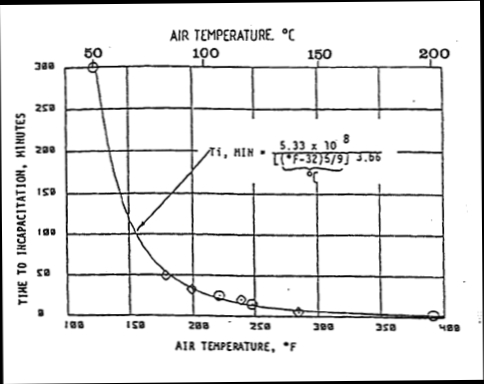
|
BRHS /
Thermal Effects from FiresThermal effects from fires are also called quaternary effects. Basically there are two phenomena linked with hydrogen fires which could harm human beings: elevated air temperature and heat radiation. Depending on the scenario only one of both or a suitable combination has to be considered. Elevated Air Temperature Effect Time to incapacitation as a function of the air temperature ([[http://www.hysafe.net/wiki/BRHS/ThermalEffectsFromFires?action=bibentry&bibfile=DB&bibref=CPR16E:2005:GreenBook | CPR16E:2005:GreenBook)]] Below 70°C, no severe effect has to be expected. Between 70°C and 150°C the time to incapacitation may be 94 minutes and 6 minutes, respectively (CPR16E:2005:GreenBook). The figure shows a plot of the empirical dependency. Other physiological responses are summarized in the following Table 1: Table 1: Elevated Air Temperature Effects
Above 150°C, the radiation effect becomes the dominant factor. Heat Radiation EffectHeat radiation may cause pain, first, second and third degree burns as well as fatal burns. The different burn types are characterised by the depth they reach in the skin. Similar as for the pressure effects a combination of the peak load, here radiation intensity, and the characteristic duration are the most important factors. Above 1.6 kW/m2, negative effects on human beings have to be expected. Table 2 relates exposure times and pain thresholds: Table 2: Threshold of Pain (KaiserW:2002)
The fatality rate may be calculated by use of probit functions. Prominent probit functions are the Eisenberg functions and the TNO functions. The first is based on nuclear radiation, the second on the radiation of hydrocarbon fires. So, both are not directly applicable to hydrogen fires. Potential knowledge gap: suitable probit function The following Table 3 based on the TNO probit function relates the exposure time and the radiation intensity for 100 % fatality: Table 3: Maximum Radiation Exposure Time (DNV:2001)
Besides the infrared content hydrogen combustion produces UV radiation capable of sunburn-like effects. Hydrogen fires are difficult to see at daylight and due to the optical properties the heat of smaller flames is felt late. Invalid BibTex Entry! << Pressure Effects from Explosions | Content | Personnel Protective Equipment >> |